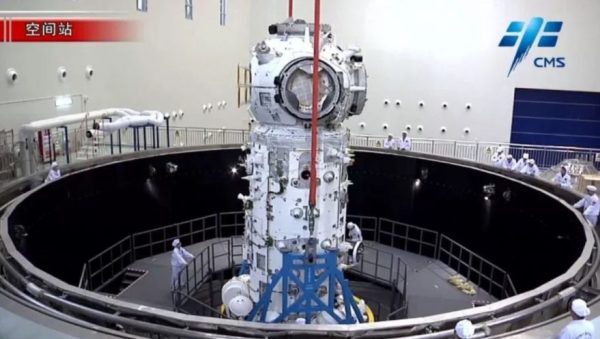Long March 5B rolled out for crewed spacecraft, space station test launch – SpaceNews
HELSINKI — China rolled out a Long March 5B launcher Wednesday for a mission to prove space station launch capabilities and test a new spacecraft for deep space human spaceflight.
Images of the Long March 5B shared on Chinese social media indicated that the rollout at Wenchang Satellite Launch Center was completed early April 29.
Launch from the coastal Wenchang launch site can now be expected around May 5. However, an official announcement has not yet been made.
The primary goal of the test flight is testing the Long March 5B for launching to low Earth orbit (LEO). If successful, launch of the ‘Tianhe’ core module for China’s space station could take place as soon as early 2021.
The payload for the test launch—a prototype new-generation crewed spacecraft—will be loaded with nearly 10 tons of propellant. This will both make the spacecraft analogous to a 20-ton-plus space station module and allow the prototype to reach higher orbits and test a high-speed reentry.
The mission will resemble the 2014 Exploration Flight Test 1 of the Orion spacecraft. The new spacecraft is expected to reach an apogee of around 8,000 kilometers (4,970 miles),
The new launcher was rolled out in March for a wet dress rehearsal. Fit checks with a prototype of the roughly 22.5-metric-ton liftoff mass Tianhe core module were also conducted.
The mission had been initially planned for mid-late April. The apparent delay follows launch failures of the first Long March 7A in March and Long March 3B earlier this month. The Yuanwang-22 cargo vessel which transports Long March 5 rocket components recently made an apparently exceptional trip to Qinglan port near Wenchang.
A successful flight of the Long March 5B would clear the way for the two-month-long launch campaign for China’s 2020 Mars mission. A standard Long March 5 will be used to launch the Tianwen-1 orbiter and rover into a Mars transfer orbit from Wenchang in late July or early August.
New-generation crewed spacecraft
The as-yet-unnamed new-generation crewed spacecraft consists of a partially reusable crew module and expendable service module. It is designed to increase China’s human spaceflight capabilities, both to LEO and beyond.
The spacecraft has two variants of around 14 and 20 metric tons respectively. The mission will test the latter, which is designed for deep space. The mission will be uncrewed and will not include life support systems.
The spacecraft will be able to carry up to six astronauts, or three astronauts and 500 kilograms of cargo to LEO. The three-module Shenzhou can carry three astronauts to LEO and has been used for all six of the country’s crewed missions.
The new spacecraft also features improved heat shielding than that used by the Shenzhou. The advanced shielding is required to survive the higher-energy reentries involved deep space missions.
Once in low Earth orbit, the two-module, 8.8-meter-long, 21.6-ton uncrewed spacecraft will use its own propulsion to raise its orbit to an apogee of around 8,000 kilometers. It will then attempt a high-speed reentry to test new heat shielding.
The mission also will test avionics, performance in orbit, parachute deployment, a cushioned airbag landing, and recovery. Planned partial reusability — by replacing the heat shielding — will also be tested.
Long March 5B
The 53.7-meter-long Long March 5B has a takeoff mass of 837.5 metric tons. The payload capacity is greater than 22 metric tons to LEO, according to the China Academy of Launch Vehicle Technology (CALT), the launcher’s designer.
It is a variant of the standard Long March 5, which had an inaugural flight in late 2016. The The Long March 5B lacks the second stage of the former. The payload fairing measures 20.5 meters in length with a diameter of 5.2 meters.
The Long March 5B is part of a new generation of Chinese launch vehicles. The Long March 5, 6 and 7 variants use combinations of liquid hydrogen or kerosene fuel with liquid oxygen. These could eventually replace the older, hypergolic Long March launchers.
The 5-meter-diameter core stage is powered by two YF-77 hydrolox engines. Each of four 3.35-meter-diameter side boosters are powered by a pair YF-100 kerolox engines. A YF-77 turbopump issue was behind the failure of the second Long March 5 in 2017. That failure delayed the test launch of the 5B and the Chang’e-5 lunar sample mission.
The test launch is the first of numerous launches required for China’s three-module space station.
“China has planned about 12 flight missions for the construction of China’s space station. The first flight mission of [the] Long March-5B rocket is also to verify its performance,” Hao Chun, director of the China Manned Space Engineering Office, told state media in January.
Launches of modules, Tianzhou cargo and refueling craft and crewed Shenzhou missions make up the flight list.







